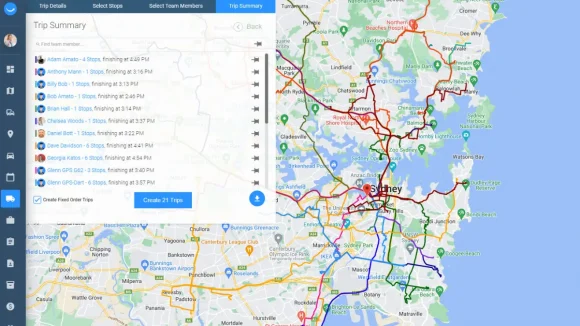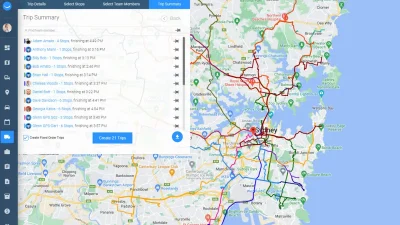With the advancement of technology, businesses now have access to powerful route optimization tools that can streamline their operations and improve overall efficiency. This article aims to explore the concept of efficient routes, the importance of optimizing delivery routes, and best practices for planning routes using route optimization tools.
One of the key tools available for route optimization is a route optimization tool, which enables businesses to analyze and plan routes in a systematic and efficient manner. These tools leverage algorithms and data analysis to generate optimized routes based on specific parameters and constraints. By incorporating factors such as traffic patterns, distance, and delivery priorities, route optimization tools can provide businesses with the most efficient route plans, minimizing unnecessary detours and maximizing resource utilization.
In the following sections, we will delve deeper into the factors to consider in route planning, explore the best practices for optimizing delivery routes, and showcase successful case studies where businesses have achieved remarkable results through efficient route planning. By adopting these practices and leveraging route optimization tools, businesses can unlock the potential for improved efficiency and success in their delivery operations.

Route Planning Best Practices
Getting the Hang of Route Planning
A. Define route planning as follows:
Route planning is the process of figuring out the best route to take when transporting products or services between two locations. It entails taking into account a number of variables, including the state of the roads, traffic patterns, vehicle limitations, delivery targets, and client demands.
B. The importance of route planning in logistics and transportation
Effective route planning decreases fuel consumption, lessens wear and tear on vehicles, and makes the best use of available resources. It aids organizations in exceeding client expectations, preserving a competitive advantage, and achieving operational excellence.
C. Advantages of thorough route planning
1. Cost savings: Optimized routes save organizations a lot of money by cutting down on labor hours, fuel costs, and vehicle maintenance costs.
2. Better customer service: On-time delivery promotes customer loyalty and satisfaction, which encourages repeat business.
3. Increased productivity: Well-planned routes allow drivers to make more deliveries in the same amount of time, hence raising productivity overall.
Considerations for Route Planning:
A. Geographical variables:
1. Road conditions and traffic patterns: Analyzing real-time traffic data enables the identification of congested locations and the development of suitable alternative routes.
2. Weather and seasonal variations: By altering routes in accordance with weather forecasts, the impact of unfavorable conditions on delivery timetables is minimized.
B. Operational elements:
1. Vehicle capacity and constraints: To avoid compliance concerns and guarantee driver safety, route planning should take into consideration vehicle size, weight restrictions, and other restrictions.
2. Driver availability and working hours: To maintain compliance with rules and avoid driver fatigue, efficient shift and break scheduling is essential.
C. Customer considerations:
1. Deadlines and delivery windows: Routes are matched to time windows that are individual to each customer to guarantee on-time deliveries and avoid service interruptions.
2. Special demands or preferences:
It’s important to take into account special requests from customers, such as preferred delivery times or detailed delivery instructions, to foster long-lasting client connections.

Route Planning Best Practices:
A. Use software for route optimization and technology
1. Advantages of automated route planning tools: Cutting-edge software solutions can determine the best routes by taking into account a variety of factors in a fraction of the time it would take to do so manually.
2. Qualities to seek for in software for route optimization: The effectiveness of route planning can be significantly increased with the use of real-time traffic updates, geocoding tools, and GPS system integration.
B. Examine past information and trends:
1. Analyzing historical data to find repeating trends: Identifying typical delivery routes, patterns, and bottlenecks enables proactive planning.
2. Modifying routes based on historical performance: Route optimization and improvement are possible when performance measures like delivery times and consumer feedback are continuously assessed.
C. Work together with key players:
1. Communication with drivers and field staff: Keeping lines of communication open with drivers and field staff enables the collection of real-time data, fast resolution of problems, and implementation of necessary adjustments.
2. Coordination with customers and suppliers: Working together with customers and suppliers can help uncover opportunities for collaboration and cost-sharing, improve processes, and provide insights into delivery requirements.
D. Take into account different forms of transportation:
1. Investigating multimodal options: Comparing the costs, environmental effects, and traffic congestion on road networks of using train, air, or water transportation for certain routes.
2. Striking a balance between speed, cost, and sustainability: Route design may be made as effective as possible by considering factors including cost-effectiveness, delivery speed, and environmental impact.
Carrying out and Monitoring Route Plans
A. Make a standard operating procedure (SOP)
1. Documenting the route planning process: By creating a clear, unified strategy, route planning may be carried out effectively and consistently.
2. Creating guidelines for handling exceptions: Creating emergency procedures and guidelines for unforeseen events like traffic accidents or customer problems is part of maintaining operational continuity.
B. Track route performance and make adjustments:
1. Monitoring key performance indicators (KPIs): Businesses can evaluate the efficacy of route planning by routinely tracking KPIs including on-time delivery rate, fuel usage, and vehicle utilization.
2. Making changes based on current information: Using current information, such as traffic updates and weather conditions, equips businesses to decide wisely and change routes as needed to reduce interruptions.
Route planning best practices: Conclusion
Efficient delivery operations are essential for success in today’s fast-paced world. Optimizing delivery routes is a key factor in ensuring cost-effective operations, maximizing resource utilization, and ultimately achieving customer satisfaction. Manual route planning can be time-consuming and prone to errors, which is why businesses should consider adopting route optimization software or utilizing delivery route planners to streamline their processes.
By implementing efficient route planning practices, businesses can significantly reduce delivery costs, improve delivery process efficiency, and enhance customer satisfaction. Utilizing route optimization tools allows companies to calculate optimal routes, considering various factors such as road conditions, traffic patterns, and delivery time windows. This not only minimizes fuel consumption and vehicle wear and tear but also ensures on-time deliveries, meeting customer expectations.
The use of delivery route optimization software empowers businesses to analyze historical data, identify trends, and make data-driven decisions for optimizing delivery routes. By continuously monitoring and adapting their routes based on real-time information, companies can further improve their delivery operations and respond effectively to unforeseen events or changes in customer demands.
Efficient route planning also contributes to cost savings by minimizing unnecessary detours, reducing fuel consumption, and optimizing driver schedules. Moreover, it enables businesses to maximize their delivery capacity and achieve higher productivity within the same timeframe.
The importance of efficient route planning cannot be overstated. By leveraging technology, adopting route optimization tools, and implementing best practices, businesses can optimize their delivery routes, reduce costs, enhance customer satisfaction, and stay ahead in the competitive market. Efficient delivery routes are the backbone of successful delivery operations, and investing in an efficient delivery route planner is a strategic decision that can yield long-term benefits for businesses of all sizes.
Optimize delivery routes with Locate2u
Ready to optimize your delivery operations and streamline your route planning? Discover the power of Locate2u, the ultimate solution for efficient and effective route optimization. Take control of your deliveries, reduce costs, and enhance customer satisfaction. Get started today and experience the difference.
Visit our website to learn more and sign up for a free trial!
About the author
Marketing Coordinator at Locate2u having completed a Bachelor of Creative Arts, majoring in English Literature and Creative Writing. I have extensive experience in editing and proofreading, as well as creating content for a range of audiences.











